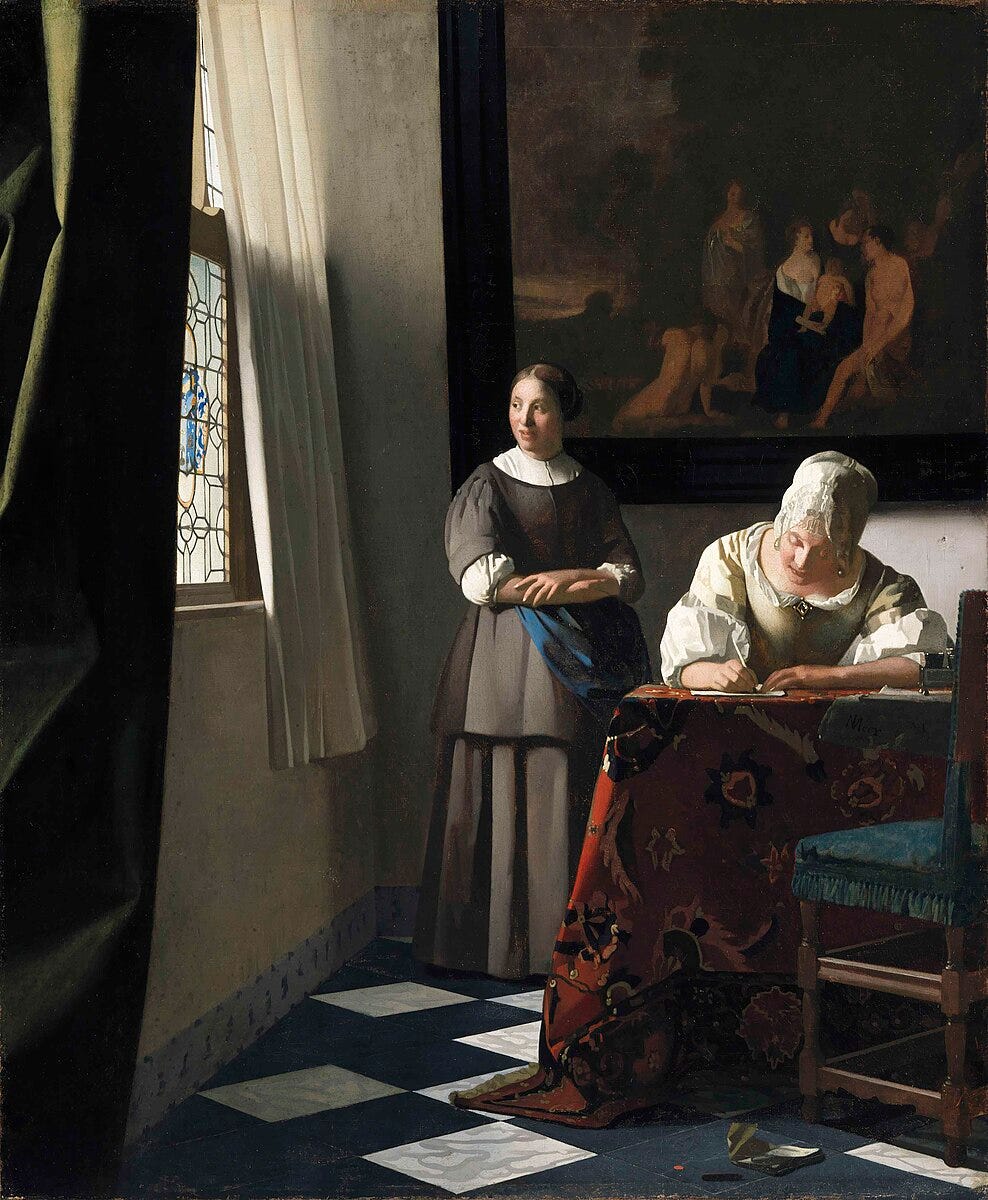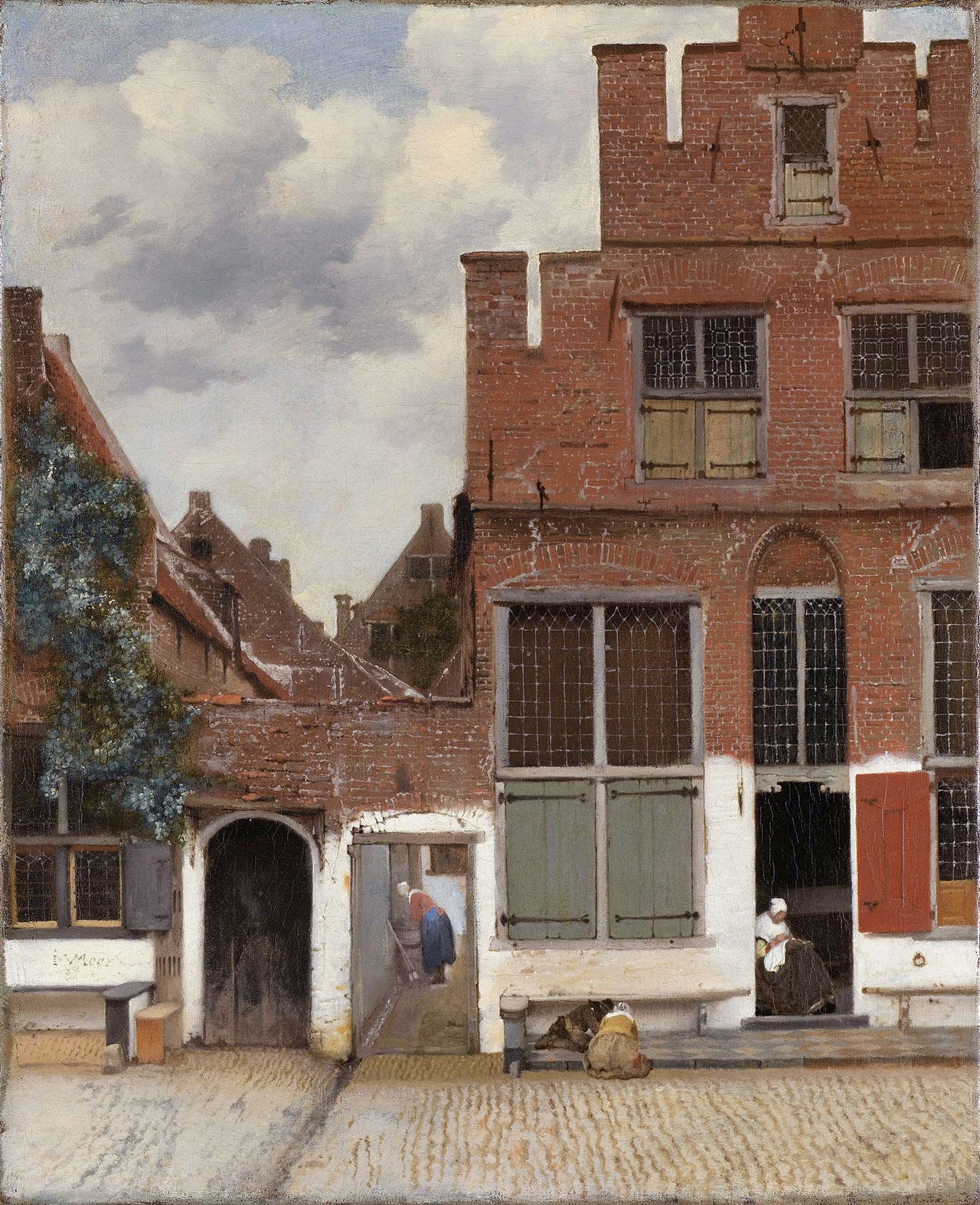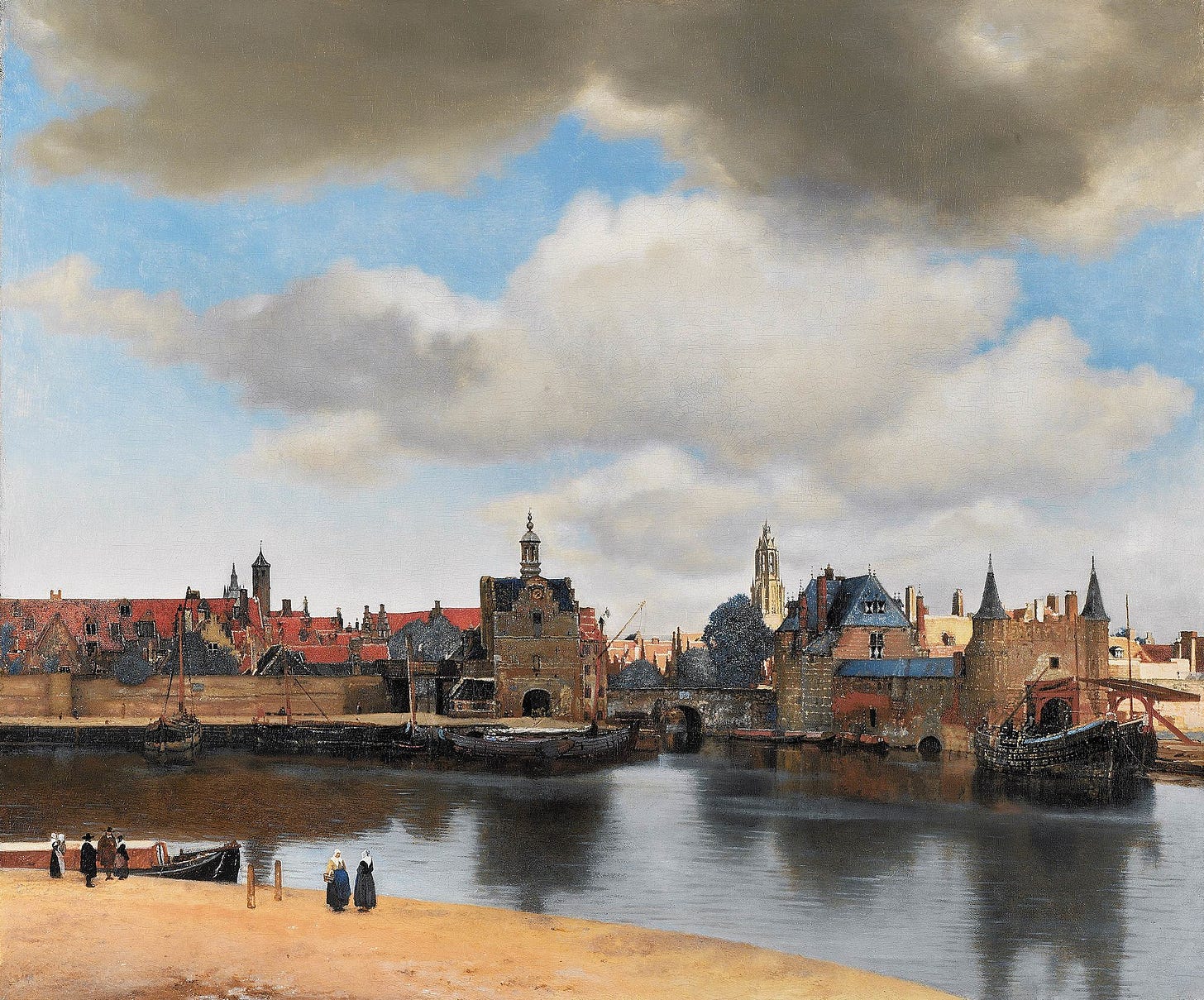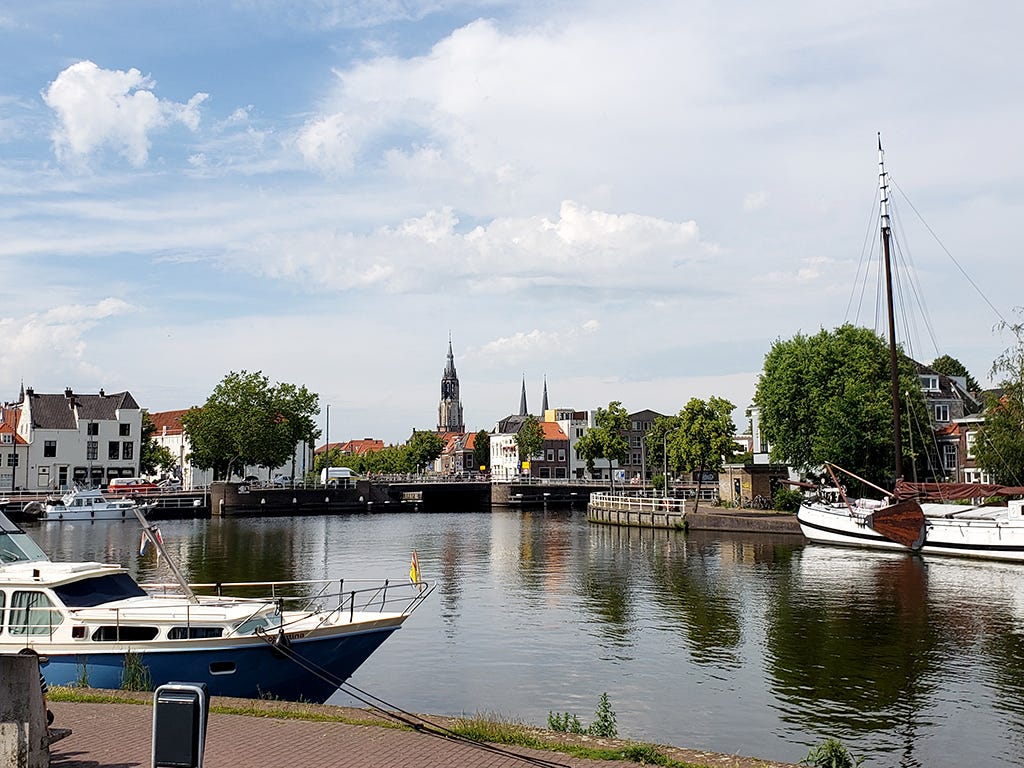Vermeer in Delft
There are no paintings by Johannes Vermeer in Delft, but the artist can still be found in his home city.

When the French writer Octave Mirbeau described Holland as a “pearl grey realm,” he was not the first to notice that the light in the Netherlands is whiter, cooler, and softer than in other places. Whether due to the angle of the sun against the flat landscapes, the low altitude, or reflections from the North Sea, the phenomenon is real.
I know it’s real because I’ve seen that light with my own eyes, and in my own photos. It is this light that the builders of Delft’s houses wanted to capture with their unusually large windows – the same windows that still highlight the figures in Johannes Vermeer’s most famous paintings.
Vermeer is a strange artist, little celebrated in his own time, nearly forgotten after his 1675 death, then resuscitated as a genius centuries later. Only 36 of his authenticated works survive, many in the hands of the world’s most prestigious museums. The Hague, Amsterdam, and New York are home to a third of his paintings.
But one city where there are precisely zero original Vermeers is Delft.
This creates a modern tourism dilemma for the city where the artist lived his entire life, and where he painted every one of his masterpieces. Since 2007, the Vermeer Centrum has gamely tried to fill this gap by displaying high-quality reproductions and “interactive exhibits” of Vermeer’s paintings in a restored Guild Hall. But the center’s connection to Vermeer, the man, feels tenuous. A warmer and more personal museum like the Rembrandthuis in Amsterdam is impossible, because the actual house where Vermeer lived and worked was demolished long ago.
Thankfully, other parts of Vermeer’s Delft are intact, if we know where to look.
Walking the streets of Delft on a quiet weekday morning, it is easy to suspect little has changed for centuries. There are almost no cars, and relatively few cyclists. The towers of Delft’s two famous churches – labeled “Oude” and “Nieuwe” but now both over 500 years old – still loom above neat rows of minimalist brick canal houses. Families still live on the upper floors, while small businesses operate on the ground floors.
The brewers, potters and textile workers who built Delft are long gone, replaced by tourists and university students. By early afternoon, small groups of people begin clustering around the cafes, drinking coffee and beers with bitterballen, just as they’ve probably done for hundreds of years.
Every so often, the modern location of the house depicted in Vermeer’s Little Street landscape is identified by research, confidently confirmed, and then debated anew. We visit one candidate, a modest rowhouse fronting a canal brimming with lily pads. It feels right, but so might a dozen other similar facades we pass on our way there. Maybe this is the point of the painting: there is nothing exceptional about the house it portrays, with two woman quietly doing chores while small children play out front. This house is every house, a glimpse of Vermeer’s Delft, perfectly preserved.

An hour or so later, near a watery junction of canals just south of the city center, we stand on a platform and photograph our own View of Delft. The two church towers and several other buildings are still recognizable from Vermeer’s painting, composed from the same vantage point around 1661. The sky, too, is familiar, a background of pale blue punctuated with white and grey clouds.
Artists and critics have long suspected that Vermeer may have used a device known as a camera obscura to help compose his paintings. When rays of light pass through a small pinhole into a darkened room or box, they project an image onto the opposite surface, upside-down and horizontally reversed. By changing the position of the pinhole and the size of the box – or by focusing the rays of light with a lens – an artist can adjust the projected image, then render it onto a canvas or board using paint or ink with great precision.
The 2013 documentary Tim’s Vermeer presented compelling evidence that paintings similar to Vermeer’s could be created with the help of a camera obscura and mirrors.
It is impossible to say for certain what tools or techniques Vermeer used, but it’s worth noting that he was a contemporary of the microbiologist Antonie van Leeuwenhoek. Both men were baptized in October of 1632 at the Nieuwe Kerk in Delft, and lived and worked only blocks apart. And both men were later interred and memorialized at the Oude Kerk.
Intriguingly, van Leeuwenhoek was particularly known for grinding optical lenses of exceptional quality, for use in his microscopes. It is possible they knew each other, considering that van Leeuwenhoek became the executor of Vermeer’s estate after Vermeer’s death. But as tempting as it is to imagine the great painter using a lens crafted by the great scientist to help create his paintings, there’s no firm evidence to support this fantasy.
If Vermeer did use a camera obscura, it would not diminish his genius. In fact, this ingenuity might explain why Vermeer is so popular today: his paintings resemble photos, and our contemporary eyes have been tuned to appreciate photography.
In a modern camera, light strikes a surface inside the device, and that light is preserved as a permanent image through chemical reactions or digital sensors. It is only a bit of a stretch, then, to suggest that Vermeer’s theoretical process of patiently matching paint colours to projected light was a form of rudimentary photography, an interim manual step on the road to the invention of chemical photography more than a century later.
If we think of Vermeer’s paintings as photos from the past, they become even more precious – rays of Delft light dutifully transcribed and passed down to us through the centuries. What is most astounding is not how different the world looked back then, but how much is still the same, if we take the time to look.


References & Further Reading
A journey of discovery through the life of Johannes Vermeer. (n.d.). Vermeer Centrum. Retrieved August 12, 2025, from https://www.vermeerdelft.nl/en
Ariaans, C. (2020, March 17). The city of Delft in the seventeenth and eighteenth centuries. Delfts Aardewerk. https://delftsaardewerk.nl/en/learn/6691-the-city-of-delft-in-the-seventeenth-and-eighteenth-centuries
Bailey, A. (2001). A View of Delft: Vermeer Then and Now. Pimlico.
De Jong, G. J. (2024, August 16). The origins of the myth. Dutch Light. https://www.dutchlight.nl/the-origins-of-the-myth/
Gezicht op Delft / View of Delft. (n.d.). Google Maps. Retrieved August 12, 2025, from https://maps.app.goo.gl/zGVS5uWqqMyJ5sMu5
Galbraith, J. (2016, November 17). The uncertain friendship of Van Leeuwenhoek and Vermeer. Corning Museum of Glass Blog. https://blog.cmog.org/2016/uncertain-friendship-van-leeuwenhoek-and-vermeer
Jenkins, S. (2017, August 10). Vermeer was an authentic artistic genius – even if he did cheat. The Guardian. https://www.theguardian.com/commentisfree/2017/aug/10/vermeer-artistic-genius-cheat-painter
Smith, G. (2019, June 21). Vermeer’s Delft. Got Away. https://www.gotaway.ca/netherlands/delft/vermeers-delft/
Srinivasan, S. (2021, February 16). 10 Things you did not know about Dutch Architecture. Rethinking The Future. https://www.re-thinkingthefuture.com/architectural-facts/dutch-arcitecture-10-things-you-did-not-know-about-dutch-architecture/
Tim’s Vermeer. (2013). IMDb. https://www.imdb.com/title/tt3089388/
Vermeer and the Camera Obscura, Part One. (n.d.). Essential Vermeer. Retrieved August 12, 2025, from https://www.essentialvermeer.com/camera_obscura/co_one.html





This reads like such a rewarding and satisfying trip, Gary. Vermeer must be one of the few artists who seems to have recently got into our collective unconscious.